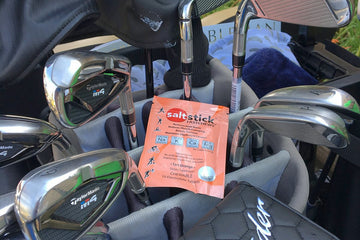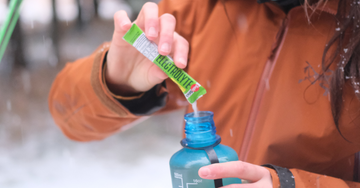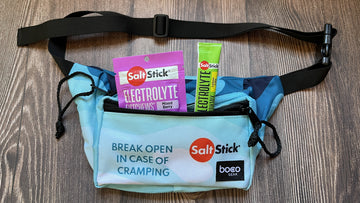Disclaimer: Contact your physician before starting any exercise program or if you are taking any medication. Individuals with high blood pressure should also consult their physician prior to taking an electrolyte supplement. Overdose of electrolytes is possible, with symptoms such as vomiting and feeling ill, and care should be taken not to overdose on any electrolyte supplement.

 Anyone who has tried their hand at golf knows it is a sweaty game. Exposed to full sunlight and humid climates, golfers must maintain a strong hydration practice to ward off unpleasant effects of dehydration or low electrolyte levels.
Unfortunately, many players could improve their approach. Due to worries about frequent bathroom breaks, a disdain for the taste of water, or poor planning, golfers can hamper their performance by not adhering to good nutritional protocol. As you’ll see, this impairment is not necessary, and with a slightly different plan, players can help ward off the problems of low focus and cramping that can result from poor hydration, as well as improve their game, enjoyment and score.
Here are five reasons golfers need electrolytes too.
Reason 1: Golf requires high levels of physical fitness
Golf is often underrated as a fitness exploit. Although players’ heart rates do not reach those of marathoners or swimmers, the game requires extensive standing, bending and walking – for several hours over the course of day. On top of that, players must lower their heart rate and maintain intense focus during strokes. It’s why most professional players engage in some form of high-intensity training to keep a strong base of fitness.
In climates hot and cold, long periods of exercise will dehydrate the body. Research conducted by scientists in Toronto for the Royal Canadian Golf Association suggested that players lose an average of approximately 2½ pounds (or 1.2 kilograms) over the course of a round, almost exclusively due to fluid loss through sweat. To account for lower blood volume, your heart will need to beat an extra 3-5 times per minute if you lose even one percent of your body weight in fluid. A three percent reduction significantly impairs performance, and anything beyond that can be dangerous.
In order to maintain peak performance, an athlete must replace both water and electrolytes; otherwise, he or she will be forced to slow down.
Reason 2: Golf usually takes place during warmer months, while players spend several hours outdoors
Many of the most popular courses are located in the southern part of the United States, while countries known for their high temperatures – including Dubai and Malaysia – are home to tournaments abroad. To learn the difference between dry heat and humid heat, along with their distinct impacts on the body, you can read our blog post on the topic here. But the bottom line is the same: In hot climates, athletes will become dehydrated faster, and it is thus doubly important to implement a rigorous hydration routine.
Reason 3: Low electrolytes can hamper focus
If you have ever played a round in the heat and found yourself utterly unable to concentrate, low electrolyte levels could be the cause.
Five electrolytes in particular play a pivotal role in maintaining normal human muscle function: sodium, potassium, magnesium, calcium, and chloride. A shortage of any of these electrolytes will affect athletic performance through a range a subtle to serious side effects. One of these side effects – a loss of focus – is particularly deleterious to a golfer’s game, as success on the course is at least as much a battle of the mind as it is physically-demanding.
Anyone who has tried their hand at golf knows it is a sweaty game. Exposed to full sunlight and humid climates, golfers must maintain a strong hydration practice to ward off unpleasant effects of dehydration or low electrolyte levels.
Unfortunately, many players could improve their approach. Due to worries about frequent bathroom breaks, a disdain for the taste of water, or poor planning, golfers can hamper their performance by not adhering to good nutritional protocol. As you’ll see, this impairment is not necessary, and with a slightly different plan, players can help ward off the problems of low focus and cramping that can result from poor hydration, as well as improve their game, enjoyment and score.
Here are five reasons golfers need electrolytes too.
Reason 1: Golf requires high levels of physical fitness
Golf is often underrated as a fitness exploit. Although players’ heart rates do not reach those of marathoners or swimmers, the game requires extensive standing, bending and walking – for several hours over the course of day. On top of that, players must lower their heart rate and maintain intense focus during strokes. It’s why most professional players engage in some form of high-intensity training to keep a strong base of fitness.
In climates hot and cold, long periods of exercise will dehydrate the body. Research conducted by scientists in Toronto for the Royal Canadian Golf Association suggested that players lose an average of approximately 2½ pounds (or 1.2 kilograms) over the course of a round, almost exclusively due to fluid loss through sweat. To account for lower blood volume, your heart will need to beat an extra 3-5 times per minute if you lose even one percent of your body weight in fluid. A three percent reduction significantly impairs performance, and anything beyond that can be dangerous.
In order to maintain peak performance, an athlete must replace both water and electrolytes; otherwise, he or she will be forced to slow down.
Reason 2: Golf usually takes place during warmer months, while players spend several hours outdoors
Many of the most popular courses are located in the southern part of the United States, while countries known for their high temperatures – including Dubai and Malaysia – are home to tournaments abroad. To learn the difference between dry heat and humid heat, along with their distinct impacts on the body, you can read our blog post on the topic here. But the bottom line is the same: In hot climates, athletes will become dehydrated faster, and it is thus doubly important to implement a rigorous hydration routine.
Reason 3: Low electrolytes can hamper focus
If you have ever played a round in the heat and found yourself utterly unable to concentrate, low electrolyte levels could be the cause.
Five electrolytes in particular play a pivotal role in maintaining normal human muscle function: sodium, potassium, magnesium, calcium, and chloride. A shortage of any of these electrolytes will affect athletic performance through a range a subtle to serious side effects. One of these side effects – a loss of focus – is particularly deleterious to a golfer’s game, as success on the course is at least as much a battle of the mind as it is physically-demanding.
 Reason 4: Low electrolytes can cause muscular cramps
A second common side effect of low electrolytes, muscle cramps can also seriously inhibit performance on the golf course. To a runner or cyclist, a cramp is a painful experience that can be muscled through; to a golfer, for whom even tiny mistakes can result in huge consequences, the stakes are much higher. Not only are cramps distracting, they can also affect your swing and biomechanics (not to mention the health of the grass...). Avoid the possibility by ensuring proper levels of electrolytes in your nutrition routine.
Reason 5: Implementing good hydration practices is an easy fix
Some aspects of golf, such as poor stroke mechanics or low levels of physical fitness, take months or even years to overcome. Proper hydration practices, however, are a lesser challenge. Better yet, they are available to anyone, as there is no need for a coach or access to special training facilities.
Every athlete’s body is unique, and you will need to experiment a bit with the right mix of water and electrolytes before you find the best solution. However, there are a few key best practices to help you get started:
Sports drinks are usually not enough: Sweat typically has about 1000 mg sodium/liter, a typical sports drink has 440 mg sodium/liter. If, during the course of training, you ingest nothing but sports drinks (or worse, water), at some point you will become hyponatremic – a dangerous condition characterized by low blood sodium levels. Many sports drinks also do not address any form of supplementation of the other key electrolytes – potassium, calcium and magnesium – potentially causing yet further cramping and muscle issues. Finally, many sports drinks contain significant amounts of simple sugars, which can have consequences as well.
A healthy diet will provide a strong foundation: The best approach to ensuring hydration throughout your day is to eat a diet rich in whole grains, nuts, fruits and vegetables. These food groups are abundant in electrolytes, as well as countless other antioxidants and healthy phytochemicals.
Reason 4: Low electrolytes can cause muscular cramps
A second common side effect of low electrolytes, muscle cramps can also seriously inhibit performance on the golf course. To a runner or cyclist, a cramp is a painful experience that can be muscled through; to a golfer, for whom even tiny mistakes can result in huge consequences, the stakes are much higher. Not only are cramps distracting, they can also affect your swing and biomechanics (not to mention the health of the grass...). Avoid the possibility by ensuring proper levels of electrolytes in your nutrition routine.
Reason 5: Implementing good hydration practices is an easy fix
Some aspects of golf, such as poor stroke mechanics or low levels of physical fitness, take months or even years to overcome. Proper hydration practices, however, are a lesser challenge. Better yet, they are available to anyone, as there is no need for a coach or access to special training facilities.
Every athlete’s body is unique, and you will need to experiment a bit with the right mix of water and electrolytes before you find the best solution. However, there are a few key best practices to help you get started:
Sports drinks are usually not enough: Sweat typically has about 1000 mg sodium/liter, a typical sports drink has 440 mg sodium/liter. If, during the course of training, you ingest nothing but sports drinks (or worse, water), at some point you will become hyponatremic – a dangerous condition characterized by low blood sodium levels. Many sports drinks also do not address any form of supplementation of the other key electrolytes – potassium, calcium and magnesium – potentially causing yet further cramping and muscle issues. Finally, many sports drinks contain significant amounts of simple sugars, which can have consequences as well.
A healthy diet will provide a strong foundation: The best approach to ensuring hydration throughout your day is to eat a diet rich in whole grains, nuts, fruits and vegetables. These food groups are abundant in electrolytes, as well as countless other antioxidants and healthy phytochemicals.
 Supplement, when necessary: During the course of exercise, it may be necessary to supplement your electrolyte intake with a product like SaltStick. Our SaltStick Caps and SaltStick Fastchews were specifically designed with athletes in mind, and they are the only products of their kind that were formulated to closely resemble the electrolyte profile lost during activity: sodium, potassium, calcium and magnesium. For suggested usage guides, please go here.
Even if your goal for the golf course is purely recreational, a proper hydration routine can still provide benefits of higher energy levels and focus. But if you view golf as a serious fitness or competitive pursuit, it is mandatory. As with every sport, competing at the highest levels requires careful attention to detail in every area, nutrition included. This change is nearly free, and so easy to implement – what more could you ask for?
Luckily, SaltStick can help take the stress out of planning by providing you with the ideal ratio of electrolytes, mimicking that of sweat: 220 sodium to 63 potassium to 16 calcium to 8 magnesium. Countless world champion athletes trust SaltStick because our products have everything you need for electrolyte replacement and nothing extra. Learn more on www.SaltStick.com.
Supplement, when necessary: During the course of exercise, it may be necessary to supplement your electrolyte intake with a product like SaltStick. Our SaltStick Caps and SaltStick Fastchews were specifically designed with athletes in mind, and they are the only products of their kind that were formulated to closely resemble the electrolyte profile lost during activity: sodium, potassium, calcium and magnesium. For suggested usage guides, please go here.
Even if your goal for the golf course is purely recreational, a proper hydration routine can still provide benefits of higher energy levels and focus. But if you view golf as a serious fitness or competitive pursuit, it is mandatory. As with every sport, competing at the highest levels requires careful attention to detail in every area, nutrition included. This change is nearly free, and so easy to implement – what more could you ask for?
Luckily, SaltStick can help take the stress out of planning by providing you with the ideal ratio of electrolytes, mimicking that of sweat: 220 sodium to 63 potassium to 16 calcium to 8 magnesium. Countless world champion athletes trust SaltStick because our products have everything you need for electrolyte replacement and nothing extra. Learn more on www.SaltStick.com.
Tags:








